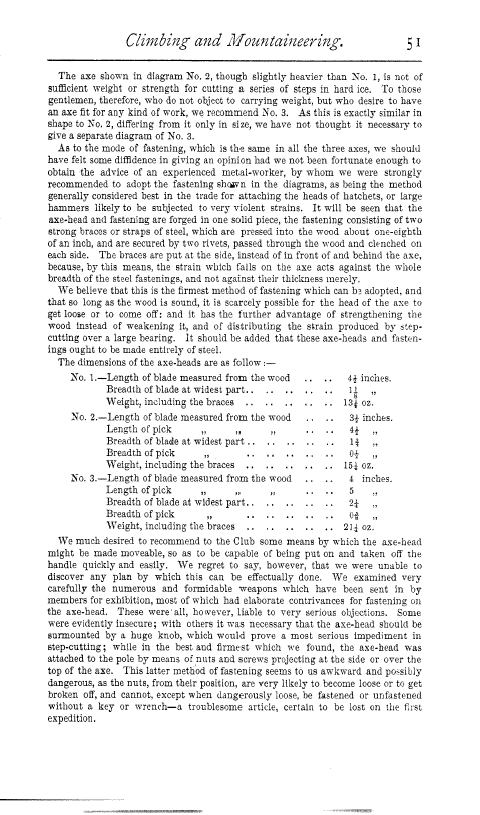Climbing and Mountaineering
The axe shown in diagram No. 2, though slightly heavier than No. 1, is not of sufficient weight or strength for cutting a series of steps in hard ice. To those gentlemen, therefore, who do not object to carrying weight, but who desire to have an axe fit for any kind of work, we recommend No. 3. As this is exactly similar in shape to No. 2, differing from it only in size, we have not thought it necessary to give a separate diagram of No. 3.
As to the mode of fastening, which is the same in all the three axes, we should have felt some diffidence in giving an opinion had we not been fortunate enough to obtain the advice of an experienced metal-worker, by whom we were strongly recommended to adopt the fastening shown in the diagrams, as being the method generally considered best in the trade for attaching the heads of hatchets, or large hammers likely to be subjected to very violent strains. It will be seen that the axe-head and fastening are forged in one solid piece, the fastening consisting of two strong braces or straps of steel, which are pressed into the wood about one-eighth of an inch, and are secured by two rivets, passed through the wood and clenched on each side. The braces are put at the side, instead of in front of and behind the axe, because, by this means, the strain which falls on the axe acts against the whole breadth of the steel fastenings, and not against their thickness merely.
We believe that this is the firmest method of fastening which can b= adopted, and that so long as the wood is sound, it is scarcely possible for the head of the axe to get loose or to come off: and it has the further advantage of strengthening the wood instead of weakening it, and of distributing the strain produced by stepcutting over a large bearing. itshould be added that these axe-heads and fastenings ought to be made entirely of steel.
The dimensions of the axe-heads are as follow:
| |
No. 1.-Length of blade measured from the wood |
.. |
4+ inches. |
| |
Breadth of blade at widest part.. |
.. |
.. |
.. |
Ig „ |
| |
Weight, including the braces .. |
.. |
.. |
. |
l3J oz. |
No. 2.-Length of blade measured from the wood 3+ inches.
Length of pick „ „ 4f 11 „
Breadth of blade at widest part .. .. l „
Breadth of pick .. 011
+
Weight, including the braces .. 15} oz.
No. 3.-Length of blade measured from the wood 4 inches.
Length of pick „ .. 5
Breadth of blade at widest part. . 2I „
Breadth of pick 11 .. .. 0+
Weight, including the braces .. 21# oz.
We much desired to recommend to the Club some means by which the axe-head might be made moveable, so as to be capable of being put on and taken off the handle quickly and easily. We regret to say, however, that we were unable to discover any plan by which this can be effectually done. We examined very carefully the numerous and formidable weapons which have been sent in by members for exhibition, most of which had elaborate contrivances for fastening on the axe-head, These were' all, however, liable to very serious objections. Some were evidently insecure; with others it was necessary that the axe-head should be surmounted by a huge knob, which would prove a most serious impediment in step-cutting; while in the best and firmest which we found, the axe-head was attached to the pole by means of nuts and screws projecting at the side or over the top of the axe. This latter method of fastening seems to us awkward and possibly dangerous, as the nuts, from their position, are very likely to become loose or to get broken off, and cannot, except when dangerously loose, be fastened or unfastened without a key or wrench-a troublesome article, certain to be lost on the first expedition.

